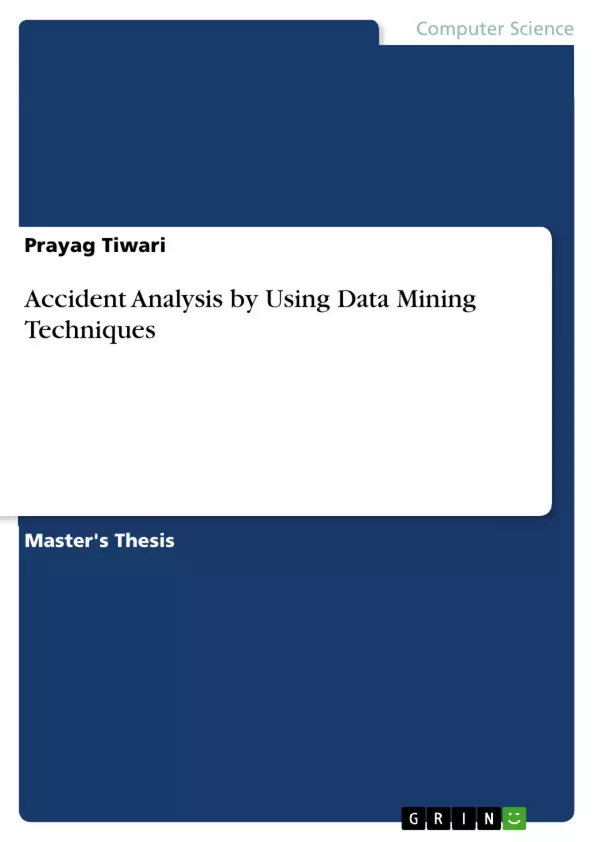Accident data analysis is one of the prime interests in the present era. Analysis of accident is very essential because it can expose the relationship between the different types of attributes that commit to an accident. Road, traffic and airplane accident data have different nature in comparison to other real world data as accidents are uncertain. Analyzing diverse accident dataset can provide the information about the contribution of these attributes which can be utilized to deteriorate the accident rate. Nowadays, Data mining is a popular technique for examining the accident dataset. In this study, Association rule mining, different classification, and clustering techniques have been implemented on the dataset of the road, traffic accidents, and an airplane crash. Achieved result illustrated accuracy at a better level and found many different hidden circumstances that would be helpful to deteriorate accident ratio in near future.
Inhaltsverzeichnis (Table of Contents)
- Abstract
- Acknowledgement
- Chapter 1: INTRODUCTION
- 1.1 Background
- 1.2 Overview of Data Mining Techniques
- 1.2.1 Clustering
- 1.2.2 Classification
- 1.2.3 Association rule mining.
- 1.3 Challenges in accident
- 1.4 Objective.
- 1.5 Organization of Thesis......
- Chapter 2: LITERATURE SURVEY
- 2.1 Introduction.......
- 2.2 Factors responsible for accident.
- 2.3 Traditional Statistical approach for accident analysis
- 2.4 Data Mining approaches for Accident Analysis.
- Chapter 3: METHODOLOGY AND DATA COLLECTION
- 3.1 Introduction.....
- 3.2 Proposed Methodology.
- 3.2.1 K-modes clustering
- 3.2.2 Self-Organizing Map (SOM).
- 3.2.3 Hierarchical Clustering.
- 3.2.4 Latent Class Clustering (LCC).
- 3.2.5 BIRCH (Balanced Iterative Reducing and Clustering using Hierarchies).
- 3.2.6 Support Vector Machine (SVM)...
- 3.2.7 Naïve Bayes (NB)..\li>
- 3.2.8 Decision Tree
- 3.2.9 Multilayer Perceptron
- 3.2.10 Association Rule Mining...
- 3.2.11 Cluster Selection Criteria...
- 3.2.12 Accuracy Measurement.
- 3.3 Data Collection
- 3.3.1 Description of dataset for Result No. 1, 2 3.
- 3.3.2 Description of dataset for Result No. 4..\li>
- 3.3.3 Description of dataset for Result No. 5..\li>
- Chapter 4: ANALYSIS AND RESULTS...............
- 4.1 Introduction..\li>
- 4.2 Result No. 1 (Road-user Specific Analysis of Traffic Accident using Data Mining
Techniques)....
- 4.2.1 Classification Analysis
- 4.2.2 Classification followed by clustering of accident..\li>
- 4.2.3 Analysis..\li>
- 4.3 Result No. 2 (Performance Evaluation of Lazy, Decision Tree Classifier and Multilayer
Perceptron on Traffic Accident Analysis)
- 4.3.1 Direct Classification Analysis
- 4.3.2 Classification followed by clustering techniques.
- 4.3.3 Analysis.....
- 4.4 Result No. 3 (A Conjoint Analysis of Road Accident Data using K-modes clustering and
Bayesian Networks).
- 4.4.1 Cluster Analysis.
- 4.4.2 Performance Evaluation of Bayesian Network
- 4.4.3 Analysis..\li>
- 4.5 Result No. 4 (Augmenting Classifiers Performance through Clustering: A Comparative
Study on Road Accident Data)...
- 4.5.1 Cluster Analysis.
- 4.5.2 Classification Analysis ...
- 4.5.3 Analysis.\li>
- 4.5 Result No. 5 (Analysis of Airplane crash by utilizing Text Mining Techniques) .
- 4.5.1 Cluster Analysis.
- 4.5.2 Association Rule Mining..\li>
- 4.5.3 Analysis.\li>
Zielsetzung und Themenschwerpunkte (Objectives and Key Themes)
This thesis aims to explore the use of data mining techniques for analyzing different types of accident data, including road traffic and airplane accidents. The goal is to identify hidden patterns and relationships within the datasets that can contribute to a better understanding of accident occurrences and potentially inform strategies for reducing accident rates.
- Analyzing accident data using data mining techniques.
- Identifying key factors contributing to accidents.
- Exploring the effectiveness of different data mining algorithms for accident analysis.
- Utilizing clustering, classification, and association rule mining techniques.
- Developing insights and recommendations for reducing accident rates.
Zusammenfassung der Kapitel (Chapter Summaries)
- Chapter 1: Introduction: This chapter provides a background on accident data analysis and introduces the importance of using data mining techniques to investigate accident occurrences. It outlines the challenges involved in analyzing such data and presents the objectives and organization of the thesis.
- Chapter 2: Literature Survey: This chapter reviews existing literature on accident analysis, examining traditional statistical approaches and exploring the use of data mining techniques in this field. It highlights key factors responsible for accidents and discusses various methodologies used in accident analysis.
- Chapter 3: Methodology and Data Collection: This chapter presents the methodology used in the study, outlining different data mining techniques employed, including clustering, classification, and association rule mining algorithms. It also discusses the datasets used for the analysis, providing descriptions of the specific accident types and attributes included.
- Chapter 4: Analysis and Results: This chapter presents the results of the accident analysis conducted using the described data mining techniques. It details the findings from different studies, including road traffic accidents and airplane crashes, and explores the effectiveness of various algorithms in identifying key factors and trends. This chapter also includes detailed analyses of the results obtained for each specific dataset and accident type.
Schlüsselwörter (Keywords)
The main keywords and focus topics of this thesis include road and traffic accidents, airplane crashes, data mining, clustering techniques, classification techniques, association rule mining, and accident rate. These keywords encapsulate the primary areas of research explored in the study, focusing on the application of data mining methodologies to understand and potentially reduce accident occurrences.
- Quote paper
- Prayag Tiwari (Author), 2017, Accident Analysis by Using Data Mining Techniques, Munich, GRIN Verlag, https://www.grin.com/document/386836



